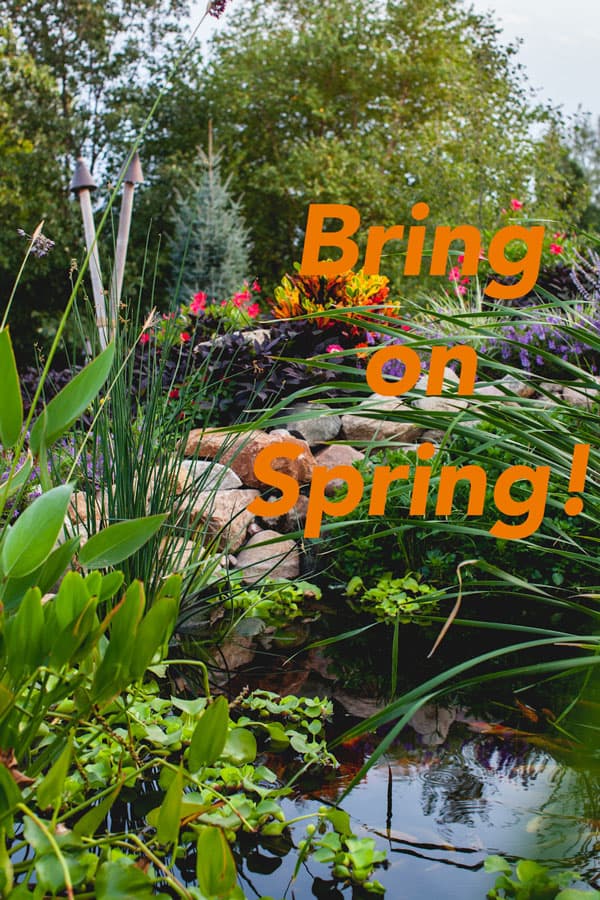24 Mar Bring on Spring!

A spring cleanup is vital to the health of your landscape as it includes everything you need to get your lawn and landscape ready for the year ahead with minimal maintenance and maximum enjoyment. With spring opening its doors early this year, people are eager to get their lawn and landscape ready for the year-ahead. Our team of professionals have identified some necessary spring tasks and tips that will have you saying,“bring on spring!”
Before you begin your spring checklist for your lawn or landscape, it is important to start with debris removal. Collect and remove all weeds, leaves and debris that have accumulated over the winter. Any debris collected during this process would be ideal to add to your compost pile if you have one! Here’s a fun fact, Sun Valley Landscaping recycles all debris to create a natural compost we use to make the best planting soil in town!
Spring Cleaning Checklist for your Landscape
Pruning
- Cut back perennials & ornamental grasses to rejuvenate (caution not to cut too short)
- Prune shrub roses in early spring when the buds begin to swell and new growth emerges (for more details, read UNL’s Article)
- Remove all dead, damaged, or diseased branches from select trees and shrubs
- Don’t trim spring-blooming plants (until after they bloom) such as: Lilac, Renaissance Spirea, or Forsythia
Spring Garden Fertilizer
- We recommend a balanced, slow-release garden fertilizer (such as 14-14-14) in the spring to feed your soil and allow your plants to thrive
- Compost is also a natural fertilization that improves your garden’s soil profile and helps with weed management
Bed Edging
- Edging between your landscape beds and turf will create a clearly defined line or “natural edge” to hold your mulch in place and prevent turf from growing into your beds
- How to: use a mechanical bed edger or spade to create a 2” vertical line between your landscape and your lawn.
- Be sure to remove any extra soil and do not enlarge your beds (unless you want to!)
- We also recommend edging along hard surfaces to hold mulch in and reinforce a consistent appearance throughout your landscape
Pre-Emergent Herbicide Application
- Bed pre-emergent acts as a barrier in your landscape beds by preventing new weeds from germinating.
- We recommend applying a bed pre-emergent (such as Snapshot or Preen) prior to installing fresh mulch each spring
Watering
- With the lack of precipitation, we recommend watering your garden, especially evergreens or new plant materials
- The important thing to remember when watering is to water plant roots deeply (and infrequently) to allow plant roots to grow deeper into the soil, which will result in more drought-resistant plants
Mulch
- Re-fresh mulch annually to enjoy a uniform appearance and fresh aroma! We recommend a consistent depth of 2”-3”inches (See our mulch blog for industry best practices!)
- Be careful to avoid mulch “volcanoes” (excessive mulch build-up around the collar of a tree)
Spring Cleaning Checklist for your Lawn
Mowing
- Good news! As your lawn is actively growing, it is now ok to start mowing turfgrass
- Mowing frequency should be based on the growth rate of your turfgrass, however, during the growing season we recommend once every 5-7 days on average
- As a general rule of thumb, raise the deck of your mower blade towards the upper settings to mow grass at a higher cut throughout the whole season
- Follow the 1/3 rule by removing no more than 1/3 of the leaf tissue during any one mowing
- For more information on mowing best practices, we recommend UNL’s article, “A Proper Mowing Key to Healthy Lawn“
Pre-Emergent and Fertilization
- We recommend a low-nitrogen, slow-release fertilizer combined with a pre-emergent each spring
- It is best to apply your pre-emergent when soil temperatures approach 55F as this is when crab grass and other weed seeds begin to germinate
- With the expedited spring and warm soils, skip the weed-n-feed this year, which is a common first-step application
- For more information on applying pre-emergent applications, we recommend UNL’s Spring Lawn Control Article
Power Rake
- Typically not necessary (especially if you aerate each year) unless you have ½ inch or deeper of thatch
- Exception to the rule: Zoysia grass (grass found on older homes), Buffalo grass, or during renovations
Seeding
- We recommend being selective when you choose to seed your lawn
- Seeding in the spring is only recommended if you have bare spots, damage, or need to spruce up your lawn for special circumstances
- Spring time is not ideal due to the inconsistent temperatures, moisture and weed competition that is more active during this time of year
- If you seed in the spring, DO NOT apply a pre-emergent because it will prevent your grass seeds from growing (affects good and bad seeds)
- The best time to seed your lawn is during the Fall due to the steady temperatures and low weed competition


